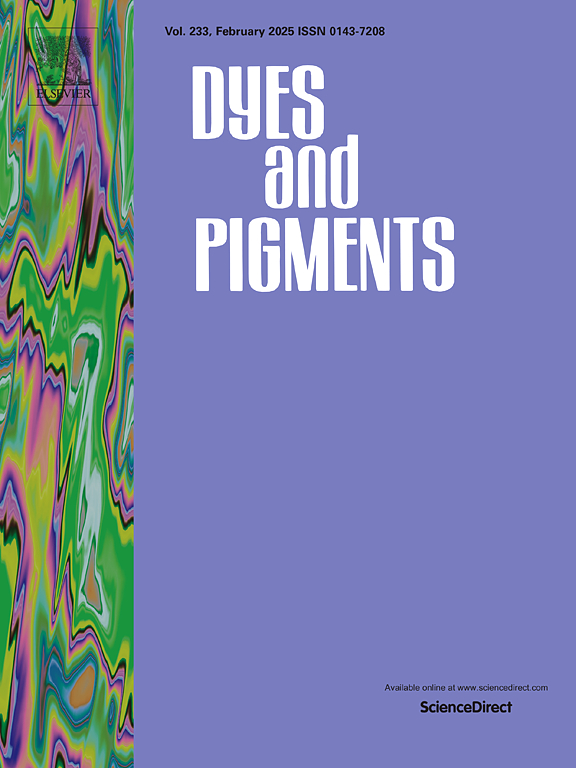5-(1,2,2-三苯基乙烯基)苯-1,2,3-三基三(芳基酸酯)末端酯基对其发射、光致变色和热致变色性能的影响:面向高对比度多功能材料
IF 4.2
3区 工程技术
Q2 CHEMISTRY, APPLIED
引用次数: 0
摘要
以5-(1,2,2-三苯基乙烯基)苯-1,2,3-三醇为原料,与苯甲酸/多环芳香族羧酸反应,制得一系列三甲酸酯。它们的光物理性质可以通过引入不同的芳香族羧酸来修饰。这些新酯具有典型的光致变色性质,四环芳香羧酸酯6g。值得注意的是,这些化合物的各种光致变色能力和刺激响应荧光可以通过芳基的变化来调节,发现苯甲酸酯比双环芳羧酸酯6e和三环芳羧酸酯6f表现出更快的光致变色行为。此外,在365 nm紫外光照射下,掺杂苯甲酸酯化合物6a的聚合物二甲基硅氧烷(PDMS)薄膜的荧光颜色呈现出从蓝色到绿松石色再到石灰绿色的显著转变,对光刺激反应显著,对比度变化大,为信息存储材料的研究开辟了新的方向。有趣的是,化合物6a掺杂不同的相变材料(不同碳链长度的烷基羧酸),得到多响应的热致变色荧光材料(TFMs)。该材料对温度变化具有较高的敏感性,在信息加密和防伪技术方面具有广阔的应用前景。本文章由计算机程序翻译,如有差异,请以英文原文为准。

The influence of the terminal ester groups of 5-(1,2,2-triphenylvinyl)benzene-1,2,3-triyl tri(aryloates) on their emission, photochromic and thermochromic properties: Towards high contrast multifunctional materials
A series of triesters were obtained by the reaction of 5-(1,2,2-triphenylvinyl)benzene-1,2,3-triol with benzoic acids/polycyclic aromatic carboxylic acids. Their photophysical properties can be modified by introducing different aromatic carboxylic acids. These new esters exhibit typical photochromic properties tetracyclic aromatic carboxylic ester 6g. Notably, the various photochromic abilities and stimuli-responsive fluorescence of these compounds could be regulated by the variation of the aryl groups, it was found that the benzoic acid ester exhibited faster photochromic behavior than the bicyclic aromatic carboxylic ester 6e and tricyclic aromatic carboxylic ester 6f. Furthermore, the polymer dimethyl siloxane (PDMS) films doped with compound 6a, benzoic acid ester, displayed a remarkable fluorescence color transfers from blue to turquoise color, then gradually to lime green under 365 nm ultraviolet (UV) irradiation, which could respond significantly to light stimuli and exhibit high-contrast variations, opening up a new direction in the study of information storage materials. Interestingly, compound 6a was doped with different phase change materials (alkyl carboxylic acids with different carbon chain lengths) to obtain multi-responsive thermochromic fluorescent materials (TFMs). These TFMs display a high sensitivity to temperature changes which show a promising application prospect in information encryption and anti-counterfeiting technology.
求助全文
通过发布文献求助,成功后即可免费获取论文全文。
去求助
来源期刊

Dyes and Pigments
工程技术-材料科学:纺织
CiteScore
8.20
自引率
13.30%
发文量
933
审稿时长
33 days
期刊介绍:
Dyes and Pigments covers the scientific and technical aspects of the chemistry and physics of dyes, pigments and their intermediates. Emphasis is placed on the properties of the colouring matters themselves rather than on their applications or the system in which they may be applied.
Thus the journal accepts research and review papers on the synthesis of dyes, pigments and intermediates, their physical or chemical properties, e.g. spectroscopic, surface, solution or solid state characteristics, the physical aspects of their preparation, e.g. precipitation, nucleation and growth, crystal formation, liquid crystalline characteristics, their photochemical, ecological or biological properties and the relationship between colour and chemical constitution. However, papers are considered which deal with the more fundamental aspects of colourant application and of the interactions of colourants with substrates or media.
The journal will interest a wide variety of workers in a range of disciplines whose work involves dyes, pigments and their intermediates, and provides a platform for investigators with common interests but diverse fields of activity such as cosmetics, reprographics, dye and pigment synthesis, medical research, polymers, etc.
 求助内容:
求助内容: 应助结果提醒方式:
应助结果提醒方式:


